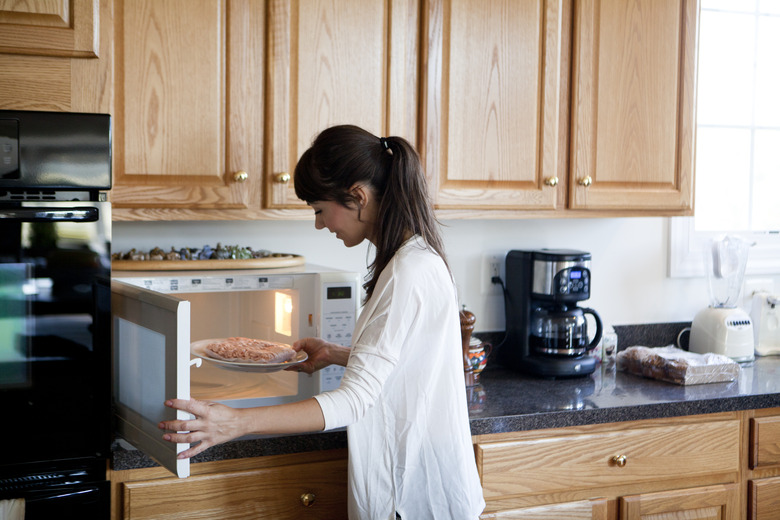How To Use The Top Of A Microwave As A Shelf
Placing items on top of the microwave that otherwise sits idle on a kitchen counter may seem like a good idea, until it's not. Some items may become damaged from the microwave or create problems as they teeter on the unit's surface while the door is opened and slammed closed. Then, there are items that can damage the kitchen appliance if they are operated while sitting on top of the microwave.
Stacking Appliances on Top of a Microwave
Stacking Appliances on Top of a Microwave
Toaster ovens and microwaves tend to get bunched together in the cooking space. If you plan to stack a toaster oven on a microwave, then you may want to lay a protective layer down first. A rubberized mat or other fire- and heat-proof material works well to secure the toaster oven so that it doesn't slide around the top of the appliance and keep the heat from transferring to the microwave.
Toaster ovens can get very hot and affect the materials around them, particularly plastic. If the top of the microwave is metal, the toaster oven can heat up and discolor the surface of the unit.
Microwave Grills for Cooking
Microwave Grills for Cooking
Placing a microwave grill or microwave-safe gadgets on top of a microwave is a safe option. This also helps with organizing in a small space.
Microwave grills have become very popular for cooking quick and healthy meals. They can be stored on top of microwave units until ready to use. However, don't leave them in the microwave, as they can overcook items.
The commercial microwave grills that are used for grilling allow the electrons to heat the plate rather than passing through it. The surface of the plate rises to a temperature that is ideal for searing thin cuts of meat without cooking it all the way through. It can also be used to brown bread, such as the oily undersurface of a pizza crust, or to produce a crisp and gooey grilled cheese sandwich.
Metal Rack for the Microwave
Metal Rack for the Microwave
The metal rack that comes with most microwaves is often tossed aside. However, it can increase the convenient uses of the microwave. It can be placed inside when needed and be stored conveniently on top of the microwave until ready to use.
By having the rack in place, you double the capacity of the microwave unit and can grill a cheese sandwich placed on the rack while warming a bowl of tomato soup below.
Only use the metal rack that came with the microwave or microwave-toaster oven combo. These have been tuned to that particular unit, and therefore won't spark when inside the appliance is in use. Make sure that the rack fits snug in the clips, or it can cause a reaction inside the unit.
Microwave Do’s and Don’ts
Microwave Do's and Don'ts
When using a microwave, there are a few basic rules to remember to keep the unit running smoothly.
First, always cover food in microwave units, particularly sauces and high-fat items like butter or eggs. These will explode. Second, don't place too many items in the microwave or they may become overcooked around the edges while still cold in the middle.
Thick slabs of frozen meat can also be difficult to thaw or cook in a microwave, making it more of a don't than a do.
Keep both the microwave and whatever sits on top of the appliance clean to ensure they operate safely. A good rule of thumb: the inside of the unit regularly, removing any plates and racks and cleaning those thoroughly, as well.
And remember, don't place any metal, other than the original metal rack that came with the unit, inside of the unit, otherwise it can cause a reaction.
